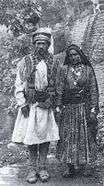Achkan

Achkan (Hindi: अचकन) also known as Baghal bandi is a knee length jacket worn by men, particularly in India, Nepal, Bangladesh and in Pakistan much like the Angarkha and Sherwani.
Etymology
The word achkan is derived from Angarkha (Sanskrit: अंगरक्षक, angrakshaka).[1] The angarkha was worn in various parts of South Asia, while the basic cut remained the same, styles and lengths varied from region to region.[2]
History
The achkan originated in India as early as 2nd century B.C as court dress for nobles and royals and was worn as everyday wear until late 20th century by general population and also by the princely states of South Asia. It can be distinguished from the Sherwani through various aspects, particularly the front opening. Achkan traditionally has side-opening tied with strings, this style of opening is known as baghal bandi but frontal opening were not uncommon, similar to Angarkha. While sherwani always has straight frontal opening, due to its function as outer-coat. Achkan, like Angarkha was traditionally worn with sash known as patka, kamarband or dora wrapped around the waist to keep the entire costume in place. While sherwani was traditionally worn as decorative outer-coat for special occasions during medieval times. Achkan is always worn with either dhoti or churidar. Achkan is made from various fabrics for both formal and informal occasions, it features traditional embroidery like gota and badla. Today, achkan is commonly worn by the grooms during South Asias wedding ceremonies or other formal festive occasions.
There are various regional variations of achkan worn throughout South Asia, and are known by regional names such as Daura in Nepal and Northeast India, Angi in Southern India and Chola or Cholu in Indian Himalayas.
Images
-

Samudragupta depicted with achkan, Gupta Empire
-
Sculpture dipicted with achkan, sash and outer coat, 1st century CE.
-
Sculpture dipicted with achkan, sash and outer coat, 1st century CE.
-

A man dressed in achkan with dora or sash wrapped around the waist.
-
Display of various styles of achkan and Angarkha worn by men, Delhi textile museum.
References
- ↑ Zaira Mis, Marcel Mis (2001) Asian Costumes and Textiles: From the Bosphorus to Fujiama
- ↑ Kumar, Ritu (2006) Costumes and textiles of royal India